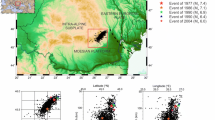Abstract
In performance-based seismic engineering, the choice of ground motion goes hand in hand with dynamic analysis. This paper presents the relationship between the various intensity measures (IMs) parameter of ground motions that can be used in evaluating the behavior of structures. This is through the relationship between them and the ratio of the peak ground acceleration to the peak ground velocity (PGA/PGV). The PGA/PGV ratio has been used an empirical parameter to estimate ground motion frequency content and categorizes ground motion suites for performing nonlinear time history analyses of structures. Regression analyses are performed on data obtained from ground motion records with different PGA/PGV ratios. The regression analyses indicate that the best correlation IMs parameter with the PGA/PGV ratio in both near- and far-source earthquakes is the mean period (Tm). Also, the relationships between PGA/PGV ratio and some IMs parameters in near-source earthquakes are stronger than it in far-source earthquakes.











Similar content being viewed by others
References
Akkar, S., & Ozen, O. (2005). Effect of peak ground velocity on deformation demands for SDOF systems. Earthquake Engineering and Structural Dynamics,34, 1551–1571. https://doi.org/10.1002/eqe.492.
Alavi, B., & Krawinkler, H. (2001). Effects of near-fault ground motions on frame structures. Technical Report Blume Center Report 138, Stanford, California.
Arias, A. (1970). A measure of earthquake intensity. In R. J. Hansen (Ed.), Seismic design for nuclear power plants (pp. 438–483). Cambridge, MA: MIT Press.
Bianchini, M., Diotallevi, P., & Baker, J. W. (2009). Prediction of inelastic structural response using an average of spectral accelerations. In 10th international conference on structural safety and reliability (ICOSSAR09), Osaka, Japan.
Campbell, K. W., & Bozorgnia, Y. (2012). A comparison of ground motion prediction equations for Arias intensity and cumulative absolute velocity developed using a consistent database and functional form. Earthquake Spectra,28, 931–941.
Chopra, A. K., & Chintanapakdee, C. (2001). Comparing response of SDF systems to near- fault and far-fault earthquake motions in the context of spectral regions. Earthquake Engineering and Structural Dynamics,30, 1769–1789.
Du, W., & Wang, G. (2017). Empirical correlations of frequency-content parameters of ground motions with other intensity measures. Soil Dynamics and Earthquake Engineering,102, 65–74. https://doi.org/10.1016/j.soildyn.2017.08.014.
Electrical Power Research Institute (EPRI). (1988) A criterion for determining exceedance of the operating basis earthquake. Report No. EPRI NP-5930, Palo Alto, CA.
FEMA. (2009). Quantification of building seismic performance factors, FEMA P695. Prepared by the Applied Technology Council for the Federal Emergency Management Agency, Washington, DC.
Garg, R., Vemuri, J. P., & Subramaniam, K. V. L. (2019). Correlating peak ground A/V ratio with ground motion frequency content. In Recent advances in structural engineering, Vol. 2, Lecture Notes in Civil Engineering 12, https://doi.org/10.1007/978-981-13-0365-4_6.
Hancock, J., & Bommer, J. (2005). The effective number of cycles of earthquake ground motion. Earthquake Engineering and Structural Dynamics,34, 637–664.
Housner, G. W. (1952). Spectrum intensities of strong-motion earthquakes. In Proceedings of the symposium on earthquake and blast effects on structures (pp. 20–36). Los Angeles, CA: Earthquake Engineering Research Institute, Los Angeles. http://resolver.caltech.edu/CaltechAUTHORS:20161010-155126031.
Kohrangi, M., Kotha, S. R., & Bazzurro, P. (2017). Ground-motion models for average spectral acceleration in a period range: direct and indirect methods. Bulletin of Earthquake Engineering,16(1), 45–65. https://doi.org/10.1007/s10518-017-0216-5.
Makris, N., & Black, J. C. (2004). Evaluation of peak ground velocity as a “good” intensity measure for near source ground motions. Journal of Engineering Mechanics,130(9), 1032–1044.
Malhotra, P. K. (2002). Cyclic-demand spectrum. Earthquake Engineering and Structural Dynamics,31, 1441–1457.
Naumoski, N., Tso, W. K., & Heidebrecht, A. C. (1988). A selection of representative strong ground motion earthquake records having different A/V ratios. Report No. EERG 88/01, Earthquake Engineering Research Group, McMaster University, Hamilton, Ontario.
Oliveira, C. S., Gassol, G., Goula, X., & Susagna, T. (2014). A European digital accelerometric database: statistical analysis of engineering parameters of small to moderate magnitude events. Earthquake Engineering and Engineering Vibration,13, 583–597. https://doi.org/10.1007/s11803-014-0265-6.
Panella, D. S., Tornello, M. E., & Frau, C. (2017). A simple and intuitive procedure to identify pulse-like ground motions. Soil Dynamics and Earthquake Engineering,94, 234–243.
Pejovica, J., & Jankovic, S. (2015). Selection of ground motion intensity measure for reinforced concrete structure. Procedia Engineering,117, 588–595.
Rathje, E. M., Abrahamson, N. A., & Bray, J. D. (1998). Simplified frequency content estimates of earthquake ground motions. Journal of Geotechnical and Geoenvironmental Engineering,124(2), 150–159.
Rathje, E. M., Faraj, F., Russell, S., & Bray, J. D. (2004). Empirical relationships for frequency content parameters of earthquake ground motions. Earthquake Spectra,20(1), 119–144.
Riddell, R., & Garcia, J. E. (2001). Hysteretic energy spectrum and damage control. Earthquake Engineering and Structural Dynamics,30, 1791–1816.
Sarma, S. K., & Yang, K. S. (1987). An evaluation of strong motion records and a new parameter A95. Earthquake Engineering and Structural Dynamics,15(1), 119–132. https://doi.org/10.1002/eqe.4290150109.
Sawada, T., Hirao, K., Yamamoto, H., & Tsujihara, O. (1992). Relation between maximum amplitude ratio (A/V, AD/V2) and spectral parameters of earthquake ground motion. In 10th world conference on earthquake engineering, Balkema, Rotterdam.
Seismo Signal. (2018). Pavia, Italy: Seism soft Ltd. Retrieved from http://www.seismosoft.com/en/HomePage.aspx.
Tavakoli, H. R., Gilani, H., & Abdollahzadeh, G. R. (2012). Comparative evaluation of seismic parameters for near-fault and far-fault earthquakes. In 15 WCEE, LISBOA.
Travasarou, T., Bray, J., & Abrahamson, N. A. (2003). Empirical attenuation relationship for Arias Intensity. Earthquake Engineering and Structural Dynamics,32, 1133–1155.
Tso, W. K., Zhu, T. J., & Heidebrecht, A. (1992). Engineering implication of ground motion A/V ratio. Soil Dynamics and Earthquake Engineering,11(3), 133–144. https://doi.org/10.1016/0267-7261(92)90027-B.
Zhu, T. J., Heidebrecht, A., & Tso, W. K. (1988). Effect of peak ground acceleration to velocity ratio on ductility demand of inelastic systems. Earthquake Engineering and Structural Dynamics,16, 63–79.
Author information
Authors and Affiliations
Corresponding author
Ethics declarations
Conflict of interest
On behalf of all authors, the corresponding author states that there is no conflict of interest.
Additional information
Publisher's Note
Springer Nature remains neutral with regard to jurisdictional claims in published maps and institutional affiliations.
Rights and permissions
About this article
Cite this article
Elhout, E.A. The correlation between the ground motion intensity measure parameters of earthquakes. Asian J Civ Eng 21, 829–840 (2020). https://doi.org/10.1007/s42107-020-00243-1
Received:
Accepted:
Published:
Issue Date:
DOI: https://doi.org/10.1007/s42107-020-00243-1




